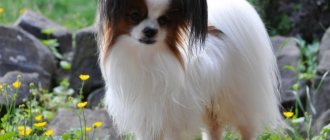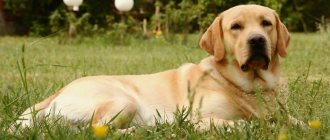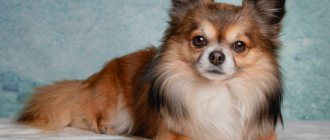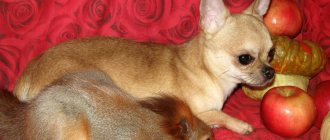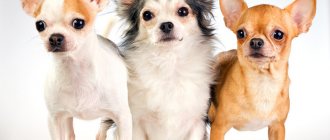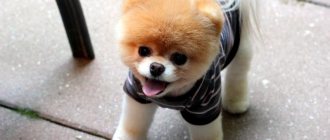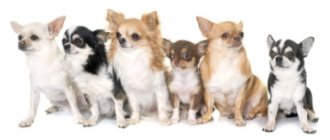The miniature dog is officially named after the Mexican state of Chihuahua, where in medieval times it was considered a sacred animal by the Indians. Opera singer Adeline Patti made a significant contribution to the popularization of the breed. In the late 19th century, the Mexican president gave her a Chihuahua hidden in a bouquet of flowers. And by the middle of the 20th century, almost every English lady acquired a Chihuahua.
The breed is one of the most popular in the world. The Chihuahua can boast of excellent upbringing and constant victories at exhibitions.
Story
The Chihuahua is the national pride of Mexico, because this is where this breed comes from. Since about 1850, there has been information that indigenous people are selling small dogs with unusual appearance to tourists.
The animal was presented to the general public in 1904 at an exhibition in the USA (Philadelphia). Almost 20 years later, Chihuahua clubs began to appear. The first one opened in 1923 in America, at which time breed standards were adopted (but so far only for smooth-haired individuals).
The British Chihuahua Club adopted new standards in 1949, and the Chihuahua breed was divided into two subspecies: long-haired and short-haired.
The origin of the Chihuahua dog is shrouded in legends. Mexican aborigines believe that the ancestors of their pets resembled monkeys because they knew how to climb trees. Ancient Indian civilizations (Aztecs, Mayans) retained memories of a tiny dog called techichi.
During excavations, archaeologists continue to discover the remains of Chihuahuas. The oldest finds date back to 1.5 thousand years BC. e., these are the burial places of the Toltec tribe (it was customary for dogs to be placed in the tomb along with their deceased owners). They got Chihuahuas from an even more ancient and mysterious civilization - the Incas.
XVI-XVIII centuries AD e. almost turned out to be fatal for the Chihuahua breed - the conquistadors from Spain (and their descendants) mercilessly exterminated the Indians along with their pets. But dog enthusiasts at the beginning of the 19th century were able to find several purebred dogs in one of the surviving Aztec settlements.
Animals began to spread across Europe not so long ago - in the 1950s, when the breed had already gained official recognition and standards. In the USSR, the first pair of Chihuahuas appeared in 1959, when the dogs were brought from Cuba as a gift to N.S. Khrushchev.
Price range
The price of a Chihuahua puppy depends on its pedigree and compliance with accepted standards. You can purchase an animal in nurseries or from breeders. It is better to do this on recommendation so as not to run into scammers. But the more popular the kennel, and the more its graduates have won awards, the more you need to pay for the dog.
How much do Chihuahua dogs usually cost:
- you will have to spend from 15 thousand to 100 thousand rubles;
- It is easy to buy an inexpensive pet if it has defects and cannot take part in exhibitions. Such a dog costs from 5 thousand to 15 thousand rubles*;
- Mini Chihuahuas are slightly more expensive than standard dogs. This is explained by fashion trends; dwarf pets or pocket dogs are at the peak of popularity.
Description
According to the standard, dogs have a slightly elongated body, stable limbs and a large head. From the side, the shape of the pet resembles a square - the length of the Chihuahua’s body is slightly greater than its height. Male individuals of the breed are stockier and more massive.
| Head | The forehead is rounded. The skull is large, widened towards the back of the head and narrowed towards the nose. Reminds me of an apple. |
| Muzzle | The transition from the forehead is noticeable and deep. The nose is shortened, slightly upturned, of any color. Cheeks and lips are slightly pronounced, dry, adjacent. A scissor or straight bite is acceptable. The teeth are white and intact. Cheekbones are poorly defined. The eyes are beautiful, expressive, round, not protruding and dark. |
| Ears | Large, in a calm state they can drop slightly (up to 45 degrees), but are usually erect. The base is wide, the tips are slightly rounded. |
| Neck | The length is average, there is no dewlap. Furry individuals have a “mane”. |
| Torso | The body is lean, balanced and compact, the top line is smooth, without deflections or bulges. The withers are slightly pronounced. The back is short and wide with a muscular loin. The chest is voluminous. The ribs are not protruding, rounded. The croup is straight or slightly sloping. The bottom is noticeably defined, the stomach is tucked. |
| Limbs | The front ones are even, parallel. The elbows are close to the body. Pasterns are well developed and flexible. The paws are small, the toes are spread out, but not too much. The hind limbs are straight, long, with pronounced angles of the hip, hock and knee joints. Quite widely spaced. |
| Tail | Set on high, thick and long, tapering to the tip. When in motion it looks like a crescent moon and never hangs below the back. When calm, lowered, slightly curved. |
| Color | There are many colors that the standard allows (black, different shades of red and brown, with tan marks). Merle color is not acceptable. |
Wool
The breed standard takes 2 types:
- Shorthair. The fur is short, close to the body, soft texture, shiny.
- Long-haired. The cover is thin, smooth, slightly wavy, silky. Longer, but moderately non-flying, hair grows on the Chihuahua's ears, neck, tail and the back of all the dog's legs.
The skin of a Chihuahua is smooth and without wrinkles.
If an animal does not meet the listed standards or has non-standard characteristics, then the dog is not allowed for breeding or exhibitions.
Varieties according to body shape
The high popularity of Chihuahuas has led to the desire of breeders to develop new varieties of the breed, differing not only in size, but also in head shape and build. This is how aboriginal, classic, extreme, Thai, Chinese, English, dwarf, deer-type, stocky Chihuahuas appeared. These varieties, as well as the individuals bred on their basis, are not recognized by any canine association and for the most part are just a commercial ploy.
All deviations from the breed standard lead to health problems and hereditary developmental anomalies in dogs.
The breed standard adopted by the FCI allows only 2 body types for Chihuahuas:
- cobby (eng. cobby - stocky);
- deer (English deer - deer).
Dogs that fully meet all the requirements of the standard are rare. For breeding, breeders prefer to use Cobby type dogs.
Cobby
The Cobby type of Chihuahua is recognized as the standard of the breed. Such dogs must have:
- strong body, wide and deep chest;
- a large head with a convex forehead and a short muzzle, set on a massive neck;
- small, widely spaced erect ears;
- wide-set, large, round eyes;
- strong straight back;
- tucked belly;
- short limbs with developed muscles;
- high-set dense and thick sickle-shaped tail.
This body type is found in both long-haired and smooth-haired representatives of the breed.
Dir
Chihuahuas of this type are strikingly different from cobbies and have a vague external resemblance to Russian toy terriers. Deer type dogs are characterized by:
- thin and fragile physique;
- long and thin limbs;
- elegant exterior;
- small head;
- large, high-set ears;
- long neck;
- smaller than that of a cobby, neck girth and distance between the eyes and ears;
- less dense coat, most often red or fawn in color;
- long thin tail.
This type of Chihuahua moves quickly and easily, but their movements do not have the strength that is inherent in the Cobby type. These dogs are inquisitive and restless, they are wary of strangers, strongly attached to their owner and cannot stand loneliness. Being owners of a high level of heat exchange and metabolism, they feel more comfortable in a warm southern climate. It is believed that the Dir type is smarter and more savvy, which is why it is easier to educate and train.
Characteristics
The dogs have a confident gait, with a wide stride and a strong lunge. Pets push off the ground powerfully. The dog's head is always raised and looks in the direction the movement is directed. The Chihuahua walks confidently, freely, and elegantly.
Dogs quickly adapt to changing conditions, are undemanding in everyday life and are able to ignore minor inconveniences. Pets are psychologically stable, especially when compared with other miniature dogs.
This is interesting: 4 less popular decorative breeds
Character of dwarf chihuahuas
The main features of the mini Chihuahua are:
- friendliness;
- kindness;
- jealousy;
- strong attachment to the owner;
- intolerance of loneliness;
- waywardness (in the absence of education, refuses to obey, can break off the leash, start a fight with another dog);
- playfulness (can run until completely exhausted).
Mini Chihuahuas love active games
Behavior and skills
A description of this mini breed would be incomplete without mentioning the courage of the Chihuahua. The little animal, without hesitation, will rush to protect its owner and its property. An attack on an enemy is accompanied by an angry bark, and the dog may even bite.
Huas are distinguished by strong jealousy towards family members. Pets show any feelings they have towards others very expressively. The dogs make contact easily. Chihuahuas wait patiently if their owner is busy. But as soon as a person pays attention to a pet, it instantly becomes playful and lively. But the energy of a mini dog is depleted quickly, so after high activity the dog often sleeps for a long time.
Where is the best place for a pet to live?
Due to its small size, this animal gets along well both in a private house and in a small city apartment. If you don’t have the opportunity to walk your pet often, get him accustomed to the cat litter box: he will relieve himself in it. As for personal space, the baby must have a permanent place to sleep and rest, in which he will feel safe. In order not to harm the small and fragile creature, for the first few weeks of the dog’s stay in the house, you can take it to a specially fenced enclosure. When the baby gets used to it, expand the area where he can walk, first locking him in the room, then enclosing a corridor for him, and then let him run around the entire apartment.
Be sure to buy your pet a special soft house in which he can settle comfortably. Place a litter tray, bowls of food and drinking water near the house so that the puppy does not look for everything he needs. It is advisable to choose a small house so that such a small dog does not freeze. As your dog gets older, you can move the food bowls and tray to their final locations - for example, put the bowls in the kitchen and take the tray to the balcony or to the toilet.
Character and appearance
Dogs are characterized by rapid growth, early development and maturation. Chihuahuas are characterized by amazing sensitivity and attentiveness. A one-year-old baby is able to understand a person’s mood and character. A dog at a distance feels anger, irritability, even conflict, so the Chihuahua will deliberately avoid communicating with certain people.
The character of each animal is unique. Dogs can be affectionate, stubborn, lively, even vicious. If from the outside Chihuahuas seem like toys sitting quietly in a lady’s purse, then the owners know that dogs do not tolerate neglect and disrespect, and only the owner has authority for them.
Expert opinion
Anna Abramenko
An avid dog lover. Experience in veterinary medicine since 2009.
Ask a Question
Children do not tolerate forced loneliness well. The pet's playfulness and cheerfulness often borders on incredible touchiness and uncontrollability.
Walks and trips
You need to walk your dog every day; it is better to take it outside twice for at least half an hour. The small animal is constantly cold and often requires clothing even indoors. Therefore, you need to have a wardrobe for any weather to protect your pet not only from frost, but from wind, rain and scorching sun.
Important! You need to walk on a leash and periodically carry the dog in your arms through difficult places.
The owner will have to buy several sets of clothes for his pet for walks
Differences between Chihuahua mini and standard
Puppies born in a litter of ordinary sires sometimes weigh differently, or some individuals lag behind others in the process of growing up. By about 2 months, the difference is already obvious - some pets gain 400-500 g, others - up to 1 kg and look larger.
By this time, all the kids are registered in the club and documents are filed for them. With a high probability, immediately stunted individuals grow slowly and are unlikely to exceed 1500 by the year. Knowing the demand among buyers for everything unique, breeders sell pets like mini-Chihuahuas. Moreover, the dogs are not suitable for further breeding.
The differences in the average weight of the breed varieties are shown in the table:
| Age in months | Super mini (kg) | Mini (kg) | Standard (kg) |
| Newborn | 0,080 | 0,115 | 0,160 |
| 1 | 0,230 | 0,370 | 0,595 |
| 2 | 0,370 | 0,610 | 0,940 |
| 3 | 0,540 | 0,850 | 1,280 |
| 4 | 0,710 | 1,110 | 1,680 |
| 5 | 0,85 | 1,300 | 1,990 |
| 6 | 0,94 | 1,450 | 2,210 |
| 18 | 1,140 | 1,820 | 2,730 |
Dwarf Chihuahuas are much weaker in health than their ordinary counterparts, so they often create a lot of additional problems for their owners.
Diseases and life expectancy
Mini Chihuahuas are prone to diseases that affect small dogs. They are not fatal and most are preventable.
The following diseases can be diagnosed in a dwarf Chihuahua:
- obesity;
- heart disease;
- hydrocephalus;
- collapse or narrowing of the trachea;
- bronchitis.
On average, dogs live from 12 to 15 years. It must be remembered that the smaller the dog, the weaker its immunity. She is more likely to get sick, including catching a cold. The life expectancy of a mini Chihuahua depends on care and attention.
Raising and training a Chihuahua
The small size of an adult dog does not prevent the animal from being very proud, arrogant and wayward. Chihuahuas are not stupid, they can quickly navigate and adapt, but they are not particularly intelligent, which creates difficulties in raising dogs.
Expert opinion
Anna Abramenko
An avid dog lover. Experience in veterinary medicine since 2009.
Ask a Question
It can sometimes be difficult to teach a Chihuahua anything, so it is necessary to start the process at 2-3 months, while the pet’s character has not yet formed. Dogs learn simple commands and simple actions quickly.
Particular attention is paid to the socialization of the breed. A mini pet cannot be kept in isolation from other animals and people. To do this, owners need to devote more time to the kids and take the Chihuahua outside every day.
Risks when buying a mini Chihuahua
When you buy a super miniature Chihuahua, you take a risk. It is difficult to guess the size and weight of an adult dog in puppyhood - the dog can grow to weigh more than one and a half kilograms. If you are lucky and the weight matches the desired one, the dog may show deviations from the standard - a small skull, an elongated muzzle, and limb defects. Mini Chihuahua varieties are long-haired and smooth-haired. In long-haired dogs the defect is excessively long and fluttering hair, in smooth-haired dogs there are bald patches on the body.
Care and maintenance
The dog causes little trouble, as it is quite unpretentious in everyday life. The compact size of pets allows them to be kept in the most cramped conditions.
Grooming rules acceptable for most breeds:
- Short but daily walks. The pet will be able to relieve itself in a cat tray (or on a diaper), so long and frequent stays in the air can be eliminated.
- When you get home, you should wash your dog's paws. But bathing a Chizuahua with special means is permissible no more than twice a month. After water treatments, your mini pet should be kept warm so that it does not catch a cold.
- The dog's nails are trimmed or filed once every 1.5-2 weeks.
- Regular hygiene of your pet's ears and eyes is necessary.
- A Chihuahua's haircut is not required, but the coat must be thoroughly combed every 5-7 days.
- Teeth are the weak point of the breed. They must be cleaned with special pastes once every 7 days. If stones form in your Chihuahua, you should contact your veterinarian immediately.
Mini dogs do not tolerate cold well, so in winter, Chihuahuas should be dressed in warm clothes for walks. Pets are taught to wear overalls from childhood, since representatives of this breed do not like to wear outfits.
Useful article: Rules for toilet training a Chihuahua
What is the difference?
Both mini and standard Chihuahuas can be born in the same litter and are in no way different from each other in the first few weeks. As the puppies grow older, it becomes noticeable that some develop and gain weight faster and more intensely than others, and already 2 weeks after birth they are almost 2 times larger than their littermates in size.
Representatives of these species have practically no differences in appearance: they have the same body type, shape of the head, paws, ear set and length of fur. The only difference between them is weight. In addition, mini Chihuahuas are more likely to have health problems, are more susceptible to various injuries and fractures, and have a lower life expectancy.
Nutrition
Chihuahuas eat little, so feeding the dogs is easy and inexpensive. A balanced diet is necessary, otherwise the pet will get sick.
This is interesting: Review of food for small breed dogs
From 7 months, puppies are switched to two meals a day. Until this age, pets are given food 4-5 times a day in small portions, gradually reducing the number of feedings and increasing their volume.
Expert opinion
Anna Abramenko
An avid dog lover. Experience in veterinary medicine since 2009.
Ask a Question
Healthy foods for a mini dog are: eggs, rice and buckwheat porridge, boiled and fresh vegetables, fruits, sea fish, veal, chicken. Fried and smoked foods, fatty meats, sweets, flour products, and pickles should be avoided in the diet.
Physical activity
Combine walks and outdoor games with training. These are very smart little ones, so encourage them to follow commands such as “no”, “come” and “sit”. Your pet's unquestioning obedience to these words will make your life much easier. These dogs are not prone to gaining excess weight, so there is no need to subject them to special physical stress. Walk your pet three times a day and let him run wild while still wearing his harness. He himself will feel tired and ask to go home. At home, keep him busy with toys and lock him in a separate room so that he can run around with a ball or shuttlecock and not hurt himself.
Health of the little Chihuahua
The Chihuahua breed has physiological characteristics, so dogs are characterized by a number of diseases:
- Eye diseases. Frequently occurring keratoconjunctivitis, glaucoma or cataracts are accompanied by increased tearfulness, redness, and blinking. Untimely treatment of your pet will lead to irreversible consequences, so at the first signs of illness you need to take your dog to the veterinarian.
- Eye loss. Occurs as a consequence of skull trauma. A dog's eyeballs only last for centuries, so this phenomenon is quite common.
- Cough. Due to the short structure of the head, it is quite difficult for dogs to breathe, especially in a state of excitement. This is normal, but if your pet’s spasms are repeated frequently, you should visit a veterinary clinic.
- Sudden attacks of epilepsy. The disease is most often inherited, but it can also be acquired. Alas, it is incurable.
- Bad breath accompanies a number of problems with your pet's teeth. Prevention – regular and thorough cleaning.
- Skin diseases. Most often, Chihuahuas develop dandruff. This indicates improper care of the pet, allergies, poor nutrition or excessive dryness of the skin. Sometimes it is worth examining your pet for the presence of parasites.
Otherwise, the animals are susceptible to common diseases, although in general the Chihuahua's health is quite good.
Types depending on size
Here are the types of Chihuahuas that vary in weight and size.
Standard
The weight of a standard Chihuahua is 1.5-3 kg.
This is the healthiest and longest-living size variety of this breed.
Standard-sized Chihuahuas are small enough to get along in even the smallest apartments and to become constant companions for their owners during shopping trips or travel.
At the same time, these dogs are devoid of signs of dwarfism, since when breeding standard Chihuahuas, there was no provision for a tendency to reduce the size of the animal.
Mini
The weight of such dogs ranges from 1 to 1.5 kg. At the same time, in appearance, minis do not differ too much from standard individuals in terms of physique, although some of them may show signs of dwarfism.
Mini Chihuahuas
are generally in good health, but are more prone to injury.
Micro
Micro Chihuahuas are tiny dogs whose weight is 0.5-1 kg. They can be predisposed to a number of diseases inherent in dwarf breeds, such as hydrocephalus, and also have an accelerated metabolism, which makes such Chihuahuas very vulnerable to both cold and heat.
CAREFULLY!
Only standard-sized bitches are suitable for breeding, since for a mini-sized Chihuahua girl, and especially micro-sized, bearing offspring, giving birth and feeding puppies is an unbearable burden and can cost her life.
Advantages and disadvantages
Fans of small breeds distinguish Chihuahuas from dogs of similar size with a number of advantages:
- self-confidence, stable psyche, patience;
- good adaptation of the Chihuahua to various conditions;
- no need for frequent walks;
- ease of dog care.
But not all characteristics of the breed are so rosy. Negative traits of a dog include:
- stubbornness;
- obsession;
- voluntary urination (in stressful situations);
- touchiness.
Expert opinion
Anna Abramenko
An avid dog lover. Experience in veterinary medicine since 2009.
Ask a Question
Dogs get along well with children. But a small child can easily injure a pet, so adults are required to be attentive and careful.
Commercial trick of unscrupulous sellers
What led to the emergence of the unofficial classification? Initially, the desire was to sell an unsuitable puppy at a price no lower than the standard one. Sellers are guided by the time and material resources spent on producing the litter. Each puppy is a commodity, so the seller strives to earn the maximum income. To increase the value of the puppy, unscrupulous breeders decided to use terms such as mini and super-mini.
Their prices are unreasonably high. There is active promotion of tiny babies, among the advantages are:
- miniature;
- uniqueness;
- fashion trend;
- saving on feed.
The new product was liked by customers and found its audience. The demand for miniature Chihuahua puppies is growing rapidly. Not surprising, because the puppy is easy to carry in your purse or in your arms, it eats very little, is not difficult to care for, and also does not take up much space in the apartment. In a word, a compact, tame pet, slightly larger than a hamster.
Breeders realized that breeding the smallest possible litter was promising and profitable. The race has begun to artificially breed the so-called mini Chihuahuas. The price of such a puppy is significantly higher, so the income from its sale is higher. Greed has clouded the conscience of many professional breeders.
Such artificial selection for breeding miniature individuals also brought its negative results. The breed is subjected to unimaginable harm, which will be most evident in the future. True, few people think about this now.
Rules for choosing puppies
The enormous popularity of the breed and the lack of proper control have led to the high probability of acquiring a Chihuahua of dubious origin. Guaranteed healthy and purebred puppies can be purchased:
- in a large well-known nursery;
- from a breeder with good recommendations.
Useful article: Nicknames for Chihuahua boys and girls: a list of beautiful and best names
Even if the dog is not needed for an exhibition, but as a family pet, you still should not buy a Chihuahua from your own hands and without documents, from a pet store or from a nursery with a dubious reputation.
A conscientious dog breeder will provide information about the producers (and demonstrate them), show documents, and answer any questions. The puppy's appearance must strictly comply with standards, and the pet's health status can be determined by its behavior and appearance.
Chihuahuas are not cheap, so there are a lot of people who want to breed and sell as many puppies as possible, regardless of the quality of the offspring.
For those who are adopting a dog for the first time
Tips for buying a Chihuahua for beginners:
- Buy a mini or super mini at the age of 4-5 months, when you can judge the future size of the dog. Ask the breeder for documents confirming the age of the litter.
- Do not believe the beliefs of breeders that the dog’s parents are champions, so he will definitely be show class. Genetics says otherwise.
- Keep in mind that minis have a shorter lifespan than standard ones.
- Be careful about the photos. Unscrupulous breeders use two types of deception: they post a photo of someone else’s puppy from the Internet or a photo of their successful one, and sell inferior quality puppies under their guise.
- Don’t “buy in” on the low price - dogs with deviations from the standard and diseases are cheap.
- The weight of dogs is often underestimated, selling them as super mini. If you want to determine the exact weight, take your own kitchen scale to the breeder.
Having seen or intuitively sensed a catch when looking at the photo, ask the breeder to photograph the dog at home or shoot a video of the baby playing with his brothers. A responsible breeder will not ignore your request and will be happy to send you materials. But if the photo from the ad is processed in a graphic editor, he will try to avoid sending other photos.
To minimize the risk of purchasing a low-quality Chihuahua, contact breeding kennels registered with the Russian Canine Federation.
Remember: smooth-haired Chihuahuas, especially minis, are born only from smooth-haired dogs. Long-haired parents are capable of producing only “long-haired” parents, while smooth-haired parents can produce both.
Interesting facts about the breed
Fast, swift and fearless dogs have a lot of unique features.
- Chihuahuas have unusually acute hearing;
- friendly disposition allows the breed to get along with most pets;
- babies do not have the unpleasant odor characteristic of dogs;
- Chihuahuas' large eyes need increased hydration, which is why they tend to be tearful;
- periodic trembling of the dog’s body is caused not by fear, but by increased metabolism;
- Pet fur is safe for allergy sufferers.
Particular attention should be paid to your pet during a walk. A dog that is invisible due to its size can be slammed by a door or kicked by passers-by, and steps and other obstacles will take a lot of energy from the pet.
Basic colors
For a Chihuahua, any color, solid or mixed, is considered acceptable.
The most popular colors for these dogs currently are:
- white;
- cream;
- sable;
- chocolate;
- black;
- bluish-gray;
- wolfish;
- brindle;
- reddish.
Two-color and three-color color types are also very popular.
Fawn or cream colored dogs may have a darkening on their face called a mask. Its size varies from a slight blackening around the nose, to a mask reaching almost to the level of the forehead.
Reviews
- “I thought for a long time about purchasing a Chihuahua. Or rather, I decided on the breed right away, but it was the opinions of others that stopped me. Like, useless, evil, always barking. I made my decision a year ago and I don’t regret it one bit. My girl is very homely, affectionate, and loves to soak up the sofa with me. On average, the breed has no more problems caring for than other pets. I recommend it to anyone who still doubts.”
- “I’m happy with my pet, he’s sociable, interesting, and takes up almost no space. Our Chihuahua Max is smooth-haired, specially chosen so that he sheds less. In vain. If you don't brush your dog regularly, you'll get prickly, hard hairs everywhere. Removing them from the sofa and carpet is somewhat difficult. Otherwise there are no complaints."
- “We were unlucky with the dog. We bought a puppy, but six months later we gave the pet away to good hands for free. A very vocal dog was caught. He barked at the sounds from the entrance, a car passing under the window, dogs barking in the distance. The Chihuahua also whined often. If noise doesn’t bother you, then this option is quite suitable.”
Defects in appearance and disqualifying defects
A color with spots is considered unacceptable. This indicates that the Chihuahua is not a purebred representative of the breed; at one time there was crossbreeding with other dogs.
How much do dogs sleep per day, as well as one-month-old puppies?
The most common disadvantages include the following:
- pointed ears;
- short neck and rather elongated body;
- curled tail.
A dog is definitely subject to disqualification if it exhibits the following signs:
- absence of a tail;
- body too elongated;
- short ears, also cropped;
- baldness;
- long legs and neck, with a very small head. The silhouette of the animal resembles a deer.
Very small dogs weighing less than 500 g, and large dogs weighing more than 3 kg are also excluded.
Note! The dog's character and behavior also matter. It is important that the dog is not cowardly or aggressive.
Photo and video review
You can learn more about the appearance and habits of the Chihuahua from the photo and video review.
For home and soul
The Chihuahua breed standard provides not only for its tiny size (the largest male does not exceed 3 kg), but also for its character and temperament. Fans of the breed note their amazing ability to please and make friends. This dog does not require special care, is unpretentious to living conditions, is very easy to raise, and easily learns basic commands.
Despite the fact that the Chihuahua breed standard shows us a very small animal, they love to play and run, and will never refuse a walk with their owner. They do not experience such a catastrophic lack of physical activity as, for example, the Doberman Pinscher
in a one-room apartment, nevertheless, it is necessary to walk with them.
How old do small dogs grow?
The childhood of dwarf Chihuahuas lasts from birth to three months. In the next two they grow intensively, and after five, physical development slows down and even stops. The puppy is in adolescence, looks rather awkward and angular - small head, narrow chest, long legs.
At six months, the teeth begin to change to permanent ones and the first shedding begins, due to which bald patches and bald spots appear on the mini’s body. Your pet's body may not have enough calcium, causing its ears to fall off. During this period, you need to introduce special mineral and vitamin supplements into your diet.
Puberty occurs at nine months - bitches have their first heat at this time. Males are ready for breeding at one year. Chihuahuas become adults, their growth stops, but they are finally formed at the age of one and a half years.
Family relationships
An exceptionally friendly creature is the Chihuahua . The breed standard (photo in our article) provides for these dogs to get along well with all family members, both two-legged and four-legged. The attitude towards strangers is somewhat distrustful, but with good upbringing the pet will demonstrate exceptional friendliness. He gets along very well with children, but you need to be careful so that the baby does not harm the puppy. With successful socialization, he is friends with animals, so from early childhood you need to introduce the puppy to cats, parrots or fish.
Weight table by month
The most reliable and accurate forecast of how much a pet should weigh can be given by its pedigree. Size, like some other parameters, is inherited. But to determine the approximate weight, you can use the weight table for Chihuahuas.
| Age/Weight of the newborn, gr. | 70 | 80 | 85 | 100 | 110 | 120 | 130 | 145 | 155 |
| 1 Week | 106 | 113 | 142 | 156 | 184 | 198 | 227 | 255 | 269 |
| 4 weeks (1 month) | 198 | 227 | 269 | 312 | 369 | 452 | 482 | 539 | 595 |
| 8 weeks (2 months) | 312 | 369 | 454 | 539 | 610 | 680 | 765 | 822 | 936 |
| 12 weeks (3 months) | 425 | 539 | 624 | 737 | 851 | 936 | 1049 | 1162 | 1276 |
| 16 weeks (4 months) | 567 | 709 | 851 | 964 | 1106 | 1247 | 1389 | 1531 | 1673 |
| 20 weeks (5 months) | 680 | 851 | 992 | 1162 | 1304 | 1474 | 1644 | 1814 | 1985 |
| 25 weeks (6 months) | 765 | 946 | 1134 | 1332 | 1503 | 1701 | 1899 | 2070 | 2269 |
| 18 months | 908 | 1135 | 1362 | 1589 | 1816 | 2043 | 2270 | 2497 | 2724 |
Estimated weight by one and a half years at a weight of 2 months:
| Weight at 2 months | Final weight of an adult dog |
| 0.30 kg | 0.90 kg |
| 0.36 kg | 1.15 kg |
| 0.45 kg | 1.35 kg |
| 0.55 kg | 1.60 kg |
| 0.60 kg | 1.80 kg |
| 0.70 kg | 2.05 kg |
| 0.76 kg | 2.25 kg |
| 0.93 kg | 2.71 kg |
| 1.10 kg | 3.18 kg |
Advantages and disadvantages of the breed
Connoisseurs and lovers of this breed may think that it has absolutely no shortcomings. However, if you have never owned a Chihuahua before, you need to weigh the pros and cons. This is a small and very cute creature that can be trained well and is well brought up. The Chihuahua becomes very attached to its owner and loves to play with him for hours on end. This is a vigilant and very loud watchman; upon hearing any rustle, he will definitely raise the alarm. At the same time, the dog is not demanding in terms of maintenance and is easy to care for.
However, there are nuances that must be paid attention to. Despite their tiny size, Chihuahuas can be aggressive and even unbearable. Therefore, when purchasing a touching baby, you must remember the need for education and training. If your pet senses the absence of a leader, he himself will try to take his place. It is difficult to correct the situation later. A small dog that constantly barks, lunges at people and provokes other dogs will create a lot of big trouble. In addition, these are very fragile creatures that need careful care.
